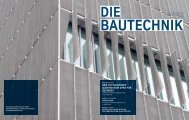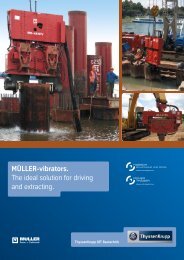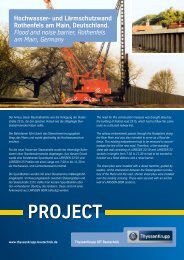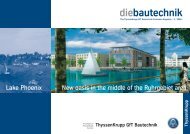MUELLER Vibrators EN - ThyssenKrupp Bautechnik
MUELLER Vibrators EN - ThyssenKrupp Bautechnik
MUELLER Vibrators EN - ThyssenKrupp Bautechnik
Create successful ePaper yourself
Turn your PDF publications into a flip-book with our unique Google optimized e-Paper software.
The<br />
M = G . r<br />
ideal combination.<br />
Proven vibrators with state-of-the-art technology.<br />
MÜLLER vibrators have a proven track record in civil engineering stretching back more than<br />
50 years. As leading-edge vibratory products they meet all market requirements. Suitable<br />
for a wide range of applications, their reliability and constant development make them a<br />
relevant market factor.<br />
How MÜLLER vibrators work.<br />
MÜLLER vibrators with fixed eccentric moment (H series).<br />
The vibrators are fitted with eccentrics which generate a fixed eccentric<br />
moment. For continuous use or use in extreme climatic conditions,<br />
vibrators can be equipped with a forced lubrication system including<br />
oil cooling (H3 series).<br />
High-frequency MÜLLER “two in one” vibrators with stepwise<br />
variable eccentric moment (HHF series).<br />
The vibrators in the HHF series are suitable for a broad range of applications.<br />
The eccentric moment can be increased or reduced in steps<br />
by adding/removing additional weights, allowing one vibrator to<br />
achieve different amplitudes and frequencies. Very high eccentric<br />
moments of up to 190 kgm can be generated.<br />
Principle of resonance-free starting and stopping.<br />
Vibrator<br />
with variable<br />
eccentric<br />
moment<br />
Vibrator<br />
with fixed<br />
eccentric<br />
moment<br />
2000<br />
1000<br />
0<br />
Ground vibration<br />
Ground vibration<br />
Frequency<br />
Starting phase<br />
Resonance frequencies<br />
Excess vibration<br />
Operating time<br />
Driving / extracting time<br />
Total operating cycle time<br />
High-frequency MÜLLER vibrators with variable eccentric<br />
moment (HFV series)<br />
When starting these vibrators, the eccentrics are arranged in such as<br />
way as to mutually balance out the centrifugal forces they generate<br />
and thus prevent any vibration. Once the required frequency has<br />
been reached, the eccentrics are turned counter to each other so<br />
that the centrifugal forces act in the same direction and generate<br />
vibration. This makes it possible to avoid passing through the resonance<br />
frequency of the soil (approx. 10 to 25 Hz depending on soil<br />
type) during starting and stopping.<br />
Resonance frequencies<br />
Stopping<br />
t<br />
t<br />
t<br />
The operating cycle can be broken down into<br />
three phases: the starting phase, the working<br />
phase and the stopping phase. The starting<br />
and stopping phases are similar in terms of<br />
vibration propagation in the soil. With a nonvariable<br />
eccentric moment, the machine<br />
passes through the soil's resonant frequency<br />
during starting and stopping.<br />
This causes the ground around the driving<br />
area to oscillate and reinforces the vibrations.<br />
This is represented by vibration peaks. If the<br />
arrangement of the eccentrics is varied during<br />
starting and stopping, the counter-rotating<br />
eccentrics balance each other out, eliminating<br />
the resonance. The settings of the eccentrics<br />
are changed when a target frequency is<br />
reached. Vibrations are only transferred into<br />
the soil by the pile during the working phase.<br />
The difference between the natural frequency<br />
range of the soil and that of the vibrator is so<br />
great that the transfer of vibrations is minimized.<br />
The spring suspension unit is activated<br />
and absorbs the vibrations that could be<br />
transferred to the carrier.
















